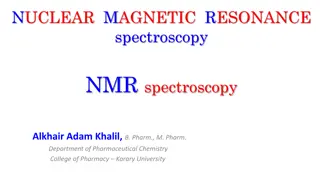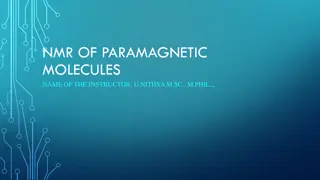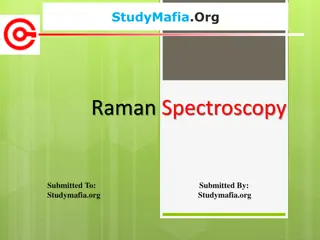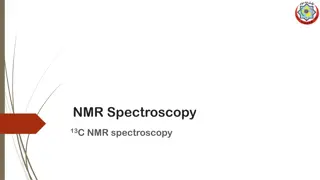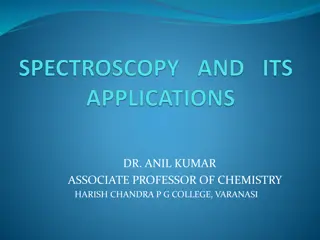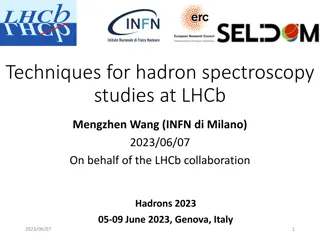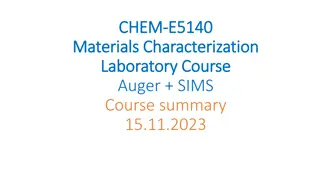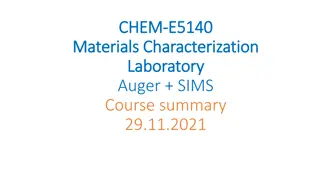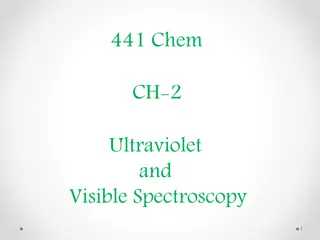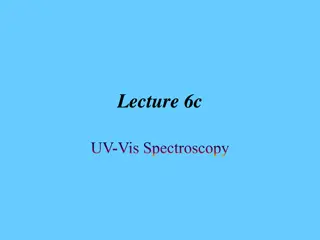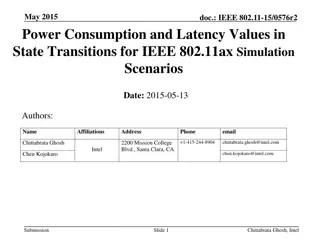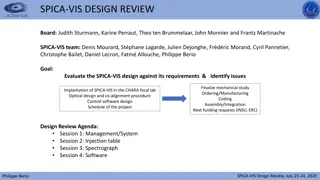Understanding UV-Vis Spectroscopy and Electronic Transitions
UV-Vis spectroscopy involves the absorption of electromagnetic radiation by molecules, causing electronic transitions. Different chromophores and conjugated systems determine the wavelength absorbed, with the Beer-Lambert Law essential for quantification. Specific compounds like caffeine showcase unique spectra, aiding in applications such as caffeine quantification in beverages.
Download Presentation

Please find below an Image/Link to download the presentation.
The content on the website is provided AS IS for your information and personal use only. It may not be sold, licensed, or shared on other websites without obtaining consent from the author. Download presentation by click this link. If you encounter any issues during the download, it is possible that the publisher has removed the file from their server.
E N D
Presentation Transcript
Lecture 3b UV-Vis Spectroscopy
Electronic Transitions Most molecules absorb electromagnetic radiation in the visible and/or the ultraviolet range. The absorption of electromagnetic radiation causes electrons to be excited, which results in a promotion from a bonding or non- bonding orbitals to an anti-bonding orbitals i.e., n- *, - *. The larger the energy gap is, the higher the frequency and the shorter the wavelength of the radiation required is (h= Planck s constant). Allowed transitions i.e., - * are usually strong (large ) while forbidden transitions (low ) i.e., n- *are much weaker. Many transition metal compounds are colored because the d-d transitions fall in the visible range (note that the d-orbitals are not shown to keep the diagram simple). hc = h = E h= 6.626*10-34 J*s c= 3.00*108 m/s
What determines the wavelength? max(nm) 178 180 480 224 246 (cm-1*mol-1*L) Chromophore 26000 900 133000 12590 9800 Compound 1,4-Pentadiene 2-Pentanone -Carotene 3-Pentenone Acetophenone isolated C=C isolated C=O conjugated C=C conjugated C=O conjugated C=O Most simple alkenes and ketones absorb in the UV-range because the * and the n- * energy gaps are quite large. Conjugation causes a bathochromic shift (red shift). Increased conjugation often also increases the peak size as well (hyperchromic). http://upload.wikimedia.org/wikipedia/commons/thumb/3/37/Beta-carotene-2D-skeletal.svg/450px-Beta-carotene-2D-skeletal.svg.png
Conjugation The - * energy gap in a C=C bond is fairly large. The - * and the n- * energy gap in a C=O bond are both fairly large as well. The combination of these two groups affords a new orbital set where n- * and the - * gaps are much smaller. If less energy is required to excite the electrons, a shift to higher wavelengths for the excitation will be observed i.e., (n- *) > ( - *). n n C=C C=C-C=O C=O
Caffeine Spectrum Caffeine is aromatic because the partial double bond between the carbon atom of the carbonyl group and nitrogen atom. UV-Vis spectrum in water shows one peak: 272 nm (8810 L/(mol*cm)). UV-Vis can be used to determine the amount of caffeine in coffee beans (A. Belay et al. Food Chemistry 2008, 108, 310) and other caffeine containing beverages (i.e., cola).
Beer Lambert Law I Fundamental law regarding absorbance of electromagnetic radiation. = * * A c l The cell dimension (l) is usually 1 cm. The -value is wavelength dependent a spectrum is a plot of the -values as the function of the wavelength. The larger the -value is, the larger the peak is going to be. The data given in the literature only list the wavelengths and -values (or its log value) of the peak maxima i.e., 331 (6460). The desirable concentration of the sample is determined by the largest and smallest -values of the peaks in the spectral window to be measured.
Beer Lambert Law II The absorbance readings for the sample have to be in the range from Amin=0.1 and Amax=1 in order to be reliable. Concentration limitations are due: Association at higher concentrations (c>10-4 M) Linear response of the detector in the UV-spectrophotometer Absorbance 1.0 Linear range 0.1 cmax cmin Concentration
Practical Aspects of UV-Vis I Cuvette It cannot absorb in the measurement window: Plastic cuvettes absorb more or less in the UV-range already. Most test tubes (borosilicates) start to absorb around 340 nm. Quartz cuvettes have a larger optical window, but are very expensive (~$100 each). It has to be stable towards the solvent and the compound: Most plastic cuvettes are etched or dissolved by low polarity solvents and can only be used with alcohols or water. Quartz cuvettes are stable when used with most organic solvents. 1. Polystyrene 2. Polymethacrylate 3. Quartz front Polyethylene cuvette
Practical Aspects of UV-Vis II Solvent Solvent Acetone Acetonitrile Chloroform Cyclohexane Dichloromethane Ethanol (abs.) Hexane Methanol Water Lower limit ( in nm) 330 190 265 210 235 210 210 210 191 Absorbance for l=1 cm 335 (0.30), 340 (0.08), 350 (0.003) 200 (0.10), 210 (0.046), 230 (0.009) 250 (0.40), 260 (0.05), 270 (0.006) 210 (0.70), 220 (0.32), 230 (0.11), 240 (0.04) 230 (1.30), 240 (0.15), 250 (0.02) 210 (0.70), 220 (0.4), 240 (0.1), 260 (0.009) 210 (0.30), 220 (0.1), 230 (0.03), 240 (0.016) 220 (0.22), 230 (0.1), 240 (0.046), 250 (0.02) Hydrocarbons and alcohols possess the largest optical windows. Note that spectrograde solvents should be used whenever possible because many non-spectrograde solvents contain additives i.e., 95 % ethanol contains aromatics that are active in the UV range!
Practical Aspects of UV-Vis III Important Pointers Since most measurements require a serial dilution, it is imperative that the entire compound is dissolved when preparing the stock solution. For the calculation of the new concentration, the student needs to keep in mind that the total volume is important i.e., if 1 mL of the stock solution was used and 9 mL of additional solvent, the concentration is one tenth of the original concentration. The student is supposed to run a full spectrum, which requires the software to be set to spectrum mode and not to fixed wavelength mode (see pop down window in the upper left hand corner).
Example I Problem: A compound displays two absorptions in the UV-Vis range, at 280 (20000) and 450 (3000). Which concentration(s) are appropriate to measure the range from 200-750 nm? Solution: The maximum concentration is given assuming a cell length of 1 cm and Amax= 1.0 Cmax=1/(20000*1 cm)= 5.00*10-5 M Using this concentration, the second peak displays an absorbance of A450= 5.00*10-5 M * 3000= 0.150 which is above the lower limit of Amin=0.100
Example I Question: How can the transitions in the example be assigned? Which color does this compound display? Answer: The transition at =280 nm is most likely a - * transition, while the peak at =450 nm is due to a n- * transition. This means that the compound most likely contains a highly conjugated carbonyl function. The compound is dark-orange in color.


